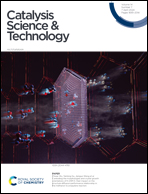Aldol condensation of mixed oxygenates on TiO2†
Abstract
Aldol condensation of mixtures of acetaldehyde, acetone and butanone was investigated over a powder TiO2 catalyst to probe a method for coupling light oxygenates generated from biomass pyrolysis into heavier, higher-value products. Self-aldol condensation (SAC) of each component was found to produce the expected dimers (e.g., crotonaldehyde from acetaldehyde, mesityl oxide from acetone) and higher molecular weight products formed from multiple coupling reactions. Mixed-aldol condensation (MAC) reactions for acetaldehyde, acetone, and butanone yielded the same products as well as cross-condensation products such as 3-penten-2-one. In MAC reactions, acetaldehyde suppressed the reaction of the other species in the mixture, such that in low-conversion reactions with equimolar feeds, crotonaldehyde dominated product selectivity. Kinetic experiments conducted with variable partial pressures of the reactants indicated a higher dependence of reactions rates on the pressures of acetone and butanone compared to acetaldehyde, consistent with a difference in the saturation of catalytic active sites between reactant molecules. Infrared spectroscopy experiments after pyridine chemisorption showed that acetaldehyde SAC reactions decreased Lewis acid site availability more quickly than acetone SAC reactions. Results from kinetic and temperature programmed desorption studies indicated that the higher rates for acetaldehyde conversion could be attributed to both its tendency to out-compete acetone for access to adsorption sites and its effectiveness as an electrophile.



 Please wait while we load your content...
Please wait while we load your content...